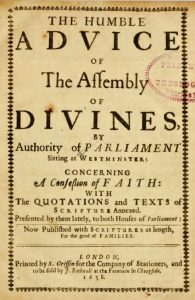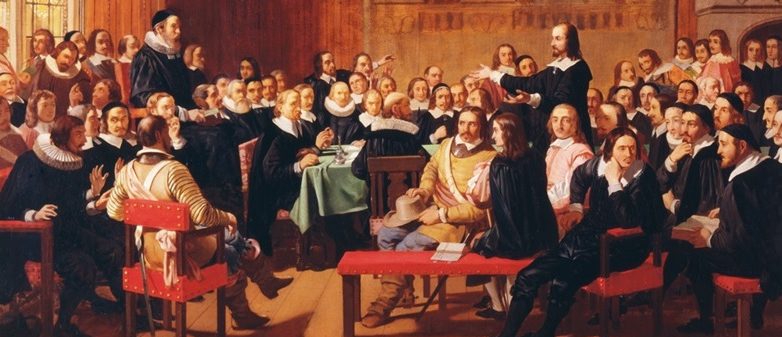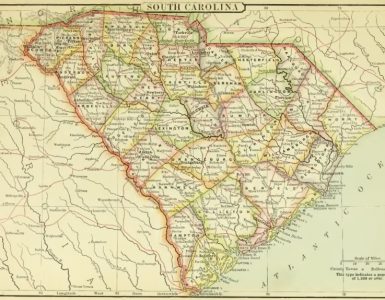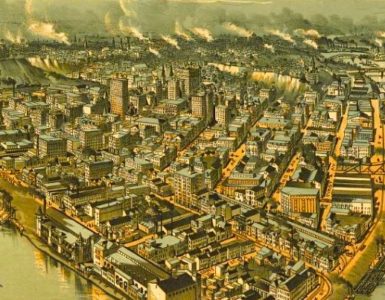 The Old and New Sides are not the same as the Old and New Schools. From 1741-1758, Presbyterians in the American Colonies were divided into the Old and New Sides. The Old Side was the Synod of Philadelphia; the New Side separated from it along with non-affiliated ministers to become the Synod of New York. The published minutes source used for the current post was issued by the Old School as Records of the Presbyterian Church in the United States of America…1706 to…1788, Philadelphia: Presbyterian Board of Publication, 1841. It includes the Old Side records, “The Minutes of the Synod of Philadelphia, from A. D. 1717-1758” and the New Side records, “Minutes of the Synod of New York, from A. D. 1745 to 1758.” Why do the New Side minutes begin in 1745 rather than 1741 when the division took place? Because it was not until then that the New Side organized its synod which would come to encompass the presbyteries of New York, New Castle, and New Brunswick with the most influential presbyters respectively Jonathan Dickinson, Samuel Blair, and Gilbert Tennent. The Old Side had no need to organize because it was already the highest judicatory of the continuing line of American Presbyterians, while those holding New Side views departed to take another course. Names of note for the Old Side are Francis Alison, John Thomson, Robert Cathcart, and Alexander McDowell. The Old Side included the presbyteries of Donegall, New Castle, and Philadelphia. It is important to know a minster’s presbytery membership during the division because it likely indicated his sympathies regarding the debates of the day.
The Old and New Sides are not the same as the Old and New Schools. From 1741-1758, Presbyterians in the American Colonies were divided into the Old and New Sides. The Old Side was the Synod of Philadelphia; the New Side separated from it along with non-affiliated ministers to become the Synod of New York. The published minutes source used for the current post was issued by the Old School as Records of the Presbyterian Church in the United States of America…1706 to…1788, Philadelphia: Presbyterian Board of Publication, 1841. It includes the Old Side records, “The Minutes of the Synod of Philadelphia, from A. D. 1717-1758” and the New Side records, “Minutes of the Synod of New York, from A. D. 1745 to 1758.” Why do the New Side minutes begin in 1745 rather than 1741 when the division took place? Because it was not until then that the New Side organized its synod which would come to encompass the presbyteries of New York, New Castle, and New Brunswick with the most influential presbyters respectively Jonathan Dickinson, Samuel Blair, and Gilbert Tennent. The Old Side had no need to organize because it was already the highest judicatory of the continuing line of American Presbyterians, while those holding New Side views departed to take another course. Names of note for the Old Side are Francis Alison, John Thomson, Robert Cathcart, and Alexander McDowell. The Old Side included the presbyteries of Donegall, New Castle, and Philadelphia. It is important to know a minster’s presbytery membership during the division because it likely indicated his sympathies regarding the debates of the day.
The subjects that contributed to the New Side ministers leaving included: the meaning of subscription to the Westminster Confession of Faith in light of its having been adopted via the Adopting Act of 1729; the problem of itinerant evangelists and Presbyterian ministers entering presbyteries without permission to conduct revivals; and questions about the quality of education provided students by the Log College operated by William Tennent in Neshaminy. The Old Side was pervasively committed to the Westminster Standards’ summary of Bible doctrine and presbyterian polity, while the New Side had lesser commitments to the Standards and were generally more open to what would be called parachurch or interdenominational ministries today. Any brief summary can be called a caricature, but confessionalism and polity are the most encompassing aspects of difference. Even the Log College was at its heart a confessional and polity disagreement. The Old School and New School were divided for thirty-two years with increased interest in reunion after the Civil War leading to its accomplishment in 1837, but the Old and New Sides kept intermittent interest in reunion throughout their eighteen-year division until they became one again in 1758. However, both subscription and the extent and power of presbyterian polity would contribute to the division of the Old and New School in 1837, and these subjects have maintained prominence throughout American Presbyterian history.
An asterisk in the list of synod meetings that follows indicates the location for the meeting was not given in the minutes. Given names of presbyters listed in the attendance roles in brackets [ ] were not in the minutes and have been inserted; the earliest minutes often enrolled commissioners with their last names only.
If you need to find information about an obscure Presbyterian minister in the American Colonies see Richard Webster, A History of the Presbyterian Church in America from Its Origin until the Year 1760, Philadelphia: Joseph M. Wilson, 1857 (the title and copyright dates disagree); a lengthy list of ministers with ordination dates and deaths is on pages 679-83.
One location for a synod meeting that is mentioned is Maidenhead. Currently Maidenhead is Lawrence Township in Mercer County, New Jersey. It is halfway between New York and Philadelphia and was a convenient rural escape to avoid an epidemic in the city.
Jonathan Edwards (1703-1758) preached the opening sermon for the 1752 New Side Synod of New York meeting. The person slated for the pulpit was absent and Edwards happened to be there.
The information provided in the following list is the year of the synod; the date it convened; the location of the gathering; the moderator and clerk elected; and the one who preached the convening sermon with his text. The Corinthian epistles were popular for moderators’ sermons and may indicate a trend for the era. In a few cases, there were two meetings of synod in one year.
The header image of the Westminster Assembly has been provided courtesy of Reformation Art. The title page for the Confession is the 1658 edition as found on Internet Archive.
Barry Waugh
Old Side, the Synod of Philadelphia
1741, convened May 27 in Philadelphia, with Jedidiah Andrews chosen moderator and Adam Boyd clerk. Moderator of the previous synod, John Pierson, was not present so Jedidiah Andrews preached from Mark 9:24.
1742, convened May 26 in Philadelphia, with Jonathan Dickinson chosen moderator and Francis Alison clerk. Moderator of the previous synod, Jedidiah Andrews, preached from 2 Cor. 4:5. Even though Dickinson became a member of the Synod of New York, at this point there were attempts to avoid a full separation.
1743, convened May 25 in Philadelphia, with David Cowell chosen moderator and Francis Alison clerk. Moderator of the previous synod, Jonathan Dickinson, preached from 1 Cor. 1:10.
1744, convened May 23 in Philadelphia, with Francis McHenry chosen moderator and Alexander McDowell clerk. Moderator of the previous synod, David Cowell, was not present so Jedidiah Andrews preached from Ezekiel 3:17.
1745, convened May 22 in Philadelphia, with Robert Cathcart chosen moderator and Alexander McDowell clerk. Moderator from the previous synod, Francis McHenry, preached from Pro. 11:30.
1746, convened May 9 in Philadelphia, with Francis Alison chosen moderator and David Griffith clerk. Moderator from the previous synod, Robert Cathcart preached from 1 Tim. 3:15,16.
1747, convened May 27 in Philadelphia, Alexander McDowell was chosen moderator and John Dick clerk. Moderator from the previous synod, Francis Alison, preached from 1 Cor. 4:1, 2.
1748, convened May 25 in Philadelphia, with John Elder chosen moderator and John Steel clerk. Moderator from the previous synod, Alexander McDowell, preached from Psa. 137:6.
1749, convened May 24 in Philadelphia, with Timothy Griffith chosen moderator and [John] Guild clerk. Moderator from the previous synod, John Elder, preached from 1 Cor. 4:1.
1750, convened May 23 in Philadelphia, with John Steel chosen moderator and Joseph Tate clerk. Moderator from the previous synod, Timothy Griffith, preached from Rom. 14:19.
1751, convened May 22* with Robert Cross chosen moderator and Hector Alison clerk. Moderator from the previous synod, John Steel, preached from 1 Cor. 4:2.
ibid. convened September 4* with Robert Cross moderator and Hector Alison clerk continuing their duties for a second meeting during the year. There is no mention of a sermon.
1752, convened May 27* with David Cowell chosen moderator and Samson Smith clerk. Moderator from the previous synod, Robert Cross, preached from 1 Tim. 4:16.
1753, convened May 23* with Hector Alison chosen moderator and Richard Zanchy clerk. Moderator from the previous synod, David Cowell, was not present so Robert Cross preached from Jer. 9:23, 24.
1754, convened May 22 in Philadelphia, with Francis McHenry chosen moderator and Samson Smith clerk. Moderator from the previous synod, Hector Alison, preached from 1 Cor. 4:2.
1755, convened May 28 in Philadelphia, with Joseph Tate chosen moderator and William Donaldson (an elder) clerk. The moderator from the previous synod, Francis McHenry, preached from Heb. 10:24.
1756, convened May 26 in Philadelphia, with [John] Guild chosen moderator and Samson Smith clerk. Moderator from the previous synod, Joseph Tate, preached from 2 Cor. 5:20.
1757, convened May 25 in Philadelphia, with Adam Boyd chosen moderator and Samson Smith clerk. The moderator from the previous synod, [John] Guild, was not present so Samson Smith, preached from Phil. 3:8.
1758, convened May 24 in Philadelphia, with Samson Smith chosen moderator and Mr. Millar (likely John Miller, father of Samuel Miller of Princeton Seminary) clerk. The moderator from the previous synod, Adam Boyd, was not present so Francis Alison preached from Eph. 4:1-8.
These are the last minutes for the Old Side, after which is inserted the following in the published version:
“The party which withdrew [Synod of New York] from the Synod of Philadelphia, the reasons and manner of whose secession are stated in the foregoing records, subsequently formed themselves into a Synod, under the style of the Synod of New York, embracing the Presbyteries of New York, New Brunswick, and New Castle. …The minutes of this body form the next link in the documentary history of the Presbyterian Church in the United States” (p. 231).
New Side, the Synod of New York
1745, convened September 19 in Elizabethtown, New Jersey, with Jonathan Dickinson chosen moderator and Ebenezer Pemberton clerk. Since this was the first meeting of the New Side, there was not a previous moderator to preach. Synod was opened with prayer and apparently no sermon.
1746, convened October 9 in New York, with Ebenezer Pemberton chosen moderator and Samuel Finley clerk. Moderator from the previous synod, Jonathan Dickinson, preached from Psa. 24:4.
1747, convened May 20 in Maidenhead, New Jersey, with Gilbert Tennent chosen moderator and Richard Treat clerk. Moderator from the previous synod, Ebenezer Pemberton, preached from Acts 4:29.
1748, convened May 18 in Maidenhead, with Joseph Lamb chosen moderator and John Blair clerk. The moderator from the previous synod, Gilbert Tennent, preached from Rom. 11:36.
1749, convened May 17 in Maidenhead, with John Pierson chosen moderator and Samuel Finley clerk. The moderator from the previous synod, Joseph Lamb, preached from 2 Cor. 5:11.
1750, convened May 16 in Maidenhead, with William Tennent chosen moderator and Thomas Arthur clerk. The moderator from the previous synod, John Pierson, preached from Col. 1:18.
ibid., convened September 27 in Newark, New Jersey, with Ebenezer Prime chosen moderator and Caleb Smith clerk. Moderator of the previous synod was not present, so [Alexander] Cummins preached from Rom. 8:15.
1751, convened September 26 in Newark, with John Blair chosen moderator and [Eliab] Byram clerk. Moderator from the previous synod, Ebenezer Prime, preached from Psa. 102:16.
1752, convened September 28 in Newark, with Richard Treat chosen moderator and Samuel Finley clerk. Moderator from the previous synod, John Blair, was not present so “the Rev. Mr. Jonathan Edwards, at the request of the members, opened the Synod with a sermon on James 2:19.” He was seated with two associates “as correspondents.” (pp. 246-47)
1753, convened October 3 in Philadelphia, with Samuel Finley chosen moderator and David Bostwick clerk. Moderator from the previous synod, Richard Treat, preached from Heb. 3:2.
1754, convened September 26 in Newark, with James Davenport chosen moderator and Charles Beatty clerk. Moderator from the previous synod, Samuel Finley, preached from 2 Cor. 10:4.
1755, convened October 1 in Philadelphia, with Aaron Burr chosen moderator and Samuel Davies clerk. Moderator from the previous synod, James Davenport, preached from 2 Cor. 4:1. Aaron Burr was the father of Aaron Burr, Jr., who killed Alexander Hamilton in a duel.
1756, convened September 30 at Newark, with William Tennent chosen moderator and Richard Treat clerk. The moderator from the previous synod, Aaron Burr, preached from Isa. 21:11, 12.
1757, convened May 18 at Maidenhead, with David Bostwick chosen moderator and Richard Treat clerk. There is no mention of a sermon. The meeting was in Maidenhead because smallpox was in New York.
1758, convened May 25 in Philadelphia, with Samuel Davies chosen moderator and John Rogers clerk. Moderator from the previous synod, David Bostwick, preached from 2 Cor. 4:5.
The following text ends the Synod of New York, New Side Minutes.
“The preceding minutes, embracing the correspondence between the Synods of Philadelphia and New York, preparatory to their union, after a separation of so many years, will serve to show that the respective parties, while they materially differed on some points, important to the purity and unity of the Church, were agreed in their doctrinal sentiments, and in the cordial adoption of the Westminster Confession and Catechisms. When, therefore, time had allayed their excited feeling, and calm reflection led them to see their errors, and to propose measures for a re-union, it was comparatively easy to settle the preliminary terms, as no difference in doctrine intervened to defeat the arrangement. “This union was happily effected in the year 1758, upon the basis which may be found on record at their first meeting as a united body. The style of the body from that period until the organization of the General Assembly, was ” The Synod of New York and Philadelphia,” the minutes of which here follow.” (p. 284)





